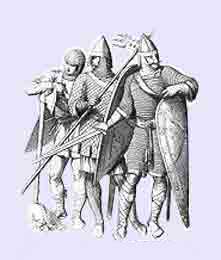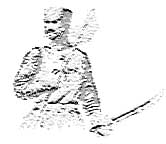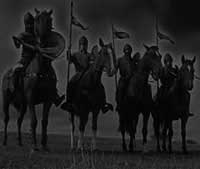The Medieval World
Medieval World Information
News
- coming soon
Links
Site Info
Welcome, Guest
The Knights Templar
The Order of Poor Knights of the Temple of Solomon

Pope Urban II set the launch date for 15 August 1096, intending the various contingents to meet at Constantinople. However, the movement developed in ways that were not what Urban or Alexius sought.
Bishops, abbots and popular preachers (eg Peter the Hermit, who claimed to see visions of mystical character) encouraged bands of common people to depart for Constantinople. They travelled via the Rhine Valley, Hungary, Bulgaria. They were weakly organised, poorly equipped and provisioned and lived off charity and robbery.
In summer 1096, Walter the Penniless and Peter reached Conatantinople with their followers Other groups perished on route. Several groups attacked Jews in the Rhine valley on route seize and took their wealth, because they were seen as enemies of faith. This was the People's Crusade . They were engaged in conflicts at Byzantium. The groups of Peter and Walter crossed the Bosphorus on 6 August and went to Civetot, where they were almost totally destroyed by Turkish army on 21 October.
As a major consequence the Byzantine authorities distrusted the 'official' crusaders. The first contingent of these arrived by sea, led by Hugh Count of Vermandois, the brother of the French king. Godfrey de Bouillon, duke of Lower Lorraine followed, leading troops from Lorraine, France and Germany. Godfrey was totally committed, having sold his lands and castles. After travelling through Hungary and Bulgaria, de Bouillon reached Byzantium on 23 December 1096. The largest contingent was led by Raymond IV Count of Toulouse and Adhemar of Le Puy. They travelled through the Balkans and arrived on 27 April 1097.

Another group of Normans from Southern Italy was led by Bohemund of Taranto, eldest son of Robert Guiscard. (He may have been disappointed that his younger brother had been made Guiscard's main heir). He was accompanied by his nephew, Tancred. They crossed by ship, and overland, arriving April 1097. Another group led by Robert II count of Flanders, Robert Curthose duke of Normandy, Stephen count of Blois travelled via southern Italy and reached Byzantium in May 1097.
The staggered arrival of bands allowed Alexius to try to assert authority over the crusade. He sought to put any lands they conquered under his dominion. He made Hugh of Vermandois swear that any lands conquered which had belonged to empire before Turks overran them would be held as imperial fiefs. Godfrey of Bouillon only agreed after a confrontation at Byzantium. Bohemund swore the oath. Raymond only swore a modified oath promising to respect the person and possessions of emperor.
The bands converged at Pelecanum. Godfrey and the Normans advanced on Nicaea, The rest arrived shortly after. A siege began on 14 May. The Kilij were defeated in battle on 21 May. Alexius sent ships overland to help. The garrison surrendered to the Greek general Butumites. The army left Nicaea 26 June, defeated the Turks near Dorylaeum on 29 June and marched to Tyana in August.

The army then split up. Tancred, Baldwin of Boulogne (brother of Godfrey Bouillon) and their troops went to the south through the Cilician gates to capture Tarsus, which Baldwin kept for himself. Baldwin then went to liberate the Armenians from Turkish overlordship, arriving at Edessa in February 1098. Edessa was controlled by the Armenian prince Thoros (underTurkish control). He was killed by his own citizens.and Baldwin invited to be ruler. He adopted the title Count of Edessa and established the first crusader state.
The main force went north to Caesarea, then SE to Marash, then Antioch. The siege began 21 October 1097 and Antioch was taken on 3 June 1098. The city was besieged by Kerbogha of Mosul. But the Crusaders defeated him in battle, on 28 June 1098.

The crusade then became embroiled in dispute over control of Antioch. An epidemic broke out. Adhemar died on 1 August. The Normans and southern French were hostile. They eventually agreed that Bohemund should rule as Count, if he agreed to promise to go to Jerusalem.
However, Muslim divisions helped the crusaders. Until his death in 1095, the dominant figure in Syria had been Tutush - the brother of Sultan Malik Shah. Tutush controlled Damascus, Jerusalem, Acre and Aleppo. His lands were divided between his sons. The Fatimids took advantage of his death to retake southern Palestine and recovered Jerusalem in 1098. The Fatimids (Shi-ites) and Seljuks (Sunnites) were mutually hostile.
A section of the Crusaders' army set out for Jerusalem under Raymond of Toulouse, on 13 January 1099. Bohemund stayed at Antioch. Their passage south was made easier as the Turkish Sunnite rulers of Damascus, Aleppo and Mosul did not want to attack them. The Emir of Tripoli paid them not to attack his city. After travelling south to Jaffa, they turned inland and Tancred took Bethlehem on 6th June. By 7th June, they reached Jerusalem and on 13-14 June they attacked the city, broke in and slaughtered its Fatimid inhabitants.